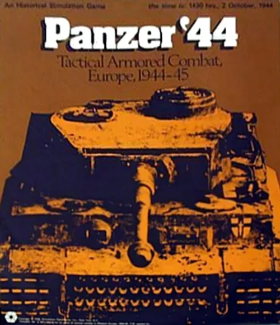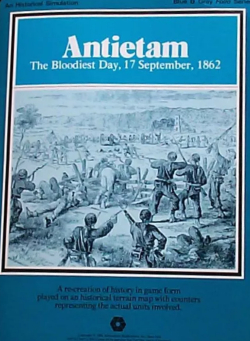
Agincourt, subtitled "The Triumph of Archery over Armor, 25 October 1415", is a board wargame published by Simulations Publications, Inc. (SPI) in 1978 that simulates the Battle of Agincourt.

Agincourt, subtitled "The Triumph of Archery over Armor, 25 October 1415", is a board wargame published by Simulations Publications, Inc. (SPI) in 1978 that simulates the Battle of Agincourt.
Agincourt is a 2-player wargame in which the English and French forces face each other at the Battle of Agincourt. The game was one of SPI's "120 Series", games that had 120 counters and could be played in 120 minutes. [1]
Each player sets up their forces at either end of the board. Each turn counts as three minutes of game time. Each player takes turns moving, after which the opponent can use archery fire. After movement is finished, units are checked for morale. If any units are adjacent to an enemy unit, melee combat is resolved with a 20-sided die, and damage uses a step-reduction system, with each damaged unit generating dead and fugitives. Fugitives move randomly, and units encountering them lose the rest of their movement. [2]
The French player wins by inflicting casualties at a rate of less than 7 French to 1 English. The English player wins by raising the casualty rate to 7 to 1 or greater. [3]
Agincourt was designed by Jim Dunnigan, [2] with artwork by Redmond A. Simonsen, and was published as a boxed set by SPI in 1979. [4]
In the July 1979 edition of Dragon (Issue #27), Tim Kask called the game "incredibly playable" but "very complex." Kask did find a major problem with the fugitives: as battles progressed, it became difficult to remember which fugitives belonged to which side, since they were both represented by identical counters: "For every line that everyone lost, there is a fugitive marker running around somewhere, or there are combined fugitive markers running around, if they all happen to form in the same hex. And these markers running around all over creation can become quite difficult to keep track of in their random movement, and which way they’re supposed to go next. And it can bog down the game and just be fugitive movement phase." However, Kask admitted the survivors were an important element of the game, and concluded "I feel that Agincourt is a major design triumph." [2]
In Issue 43 of Moves , Charles Vasey was not impressed, saying, "If the game adequately simulates the battle, I cannot say I find it a good game. It seems to me to be both long and tiresome with a multitude of dice and calculations." Vasey thought the lack of viable tactics the worst part of this game. He concluded, "Agincourt is not a game I would play again." [5]
In the next issue of Moves, David Smith concurred with Vasey. He felt the game was fatally unbalanced against the French, pointing out "there is no other possible outcome than needless die-rolling, record-keeping, and eventually French slaughter." He admired the combat system, which he called "novel", but felt that it was lost on this game, and suggested, "The archery tables, morale concepts, and personal combat ideas are all ready to be transported into a more fitting subject." He concluded by suggesting that historians would congratulate SPI for accurately depicting the inevitable French defeat, but "the gamer will hope that [the game designers] apply the same reasoning to other battles with less predestined results." [3]
In Issue 24 of Phoenix , John Lee though this game was "a surprisingly detailed and enjoyable game for its size. The rule book is short and to the point." [1]
In the 1980 book The Complete Book of Wargames , game designer Jon Freeman noted "This is the first game really to treat medieval warfare as a serious subject. The system is intense — down to lost arrows and dead bodies littering the field." However, Freeman concluded on a down note, saying, "As a history lesson, Agincourt is virtually without peer. As a game, it is a stultifying bore, replete with endless die-rolling and a total lack of heart-stopping action." [6]

Blitzkrieg is a strategic-level wargame published by Avalon Hill in 1965 that simulates a non-historical attack by one major power against another using the blitzkrieg strategy. It was the first commercial wargame that did not simulate an actual historical battle, and with almost 400 counters, it was a precursor to the "monster" wargames of the 1970s featuring more than a thousand counters.

War in Europe is a grand strategic "monster" board wargame published by Simulations Publications Inc. (SPI) in 1976 that attempts to simulate the entirety of the European theatre of World War II from 1939 to 1945. One of the largest wargames ever produced, War in Europe features 4000 counters, four rulebooks, and nine maps that when placed together cover an area of 38.5 ft2. The game is nominally a three-player game, but each side can be represented by teams of players. SPI estimated the full game would take at least 180 hours.

Conquistador, originally subtitled "The Age of Exploration: 1495–1600", is a board game published by Simulations Publications, Inc. (SPI) in 1976 that simulates the exploration of the New World in the 16th century. Players take on the role of European countries sending expeditions to find gold and establish colonies. Although the design uses the trappings of board wargames such as a hex map, combat is not a major part of the game.

Golan subtitled "Syrian-Israeli Combat in the '73 War", is a board wargame published by Simulations Publications, Inc. (SPI) in 1975 that simulates operational level ground combat between Egypt and Israel on the Golan Heights during the just completed Yom Kippur War of October 1973. Golan was originally published as part of the "quadrigame" Modern Battles: Four Contemporary Conflicts.

To the Green Fields Beyond, subtitled "The Battle of Cambrai, 1917" is a board wargame published by Simulations Publications, Inc. in 1978 that simulates the appearance of tanks for the first time during the First World War.

Napoleon's Last Battles is a board wargame published by Simulations Publications in 1976 that simulates the last four battles fought by Napoleon. It was one of SPI's most popular games, and also received many positive reviews.
La Bataille de la Moscowa is a board wargame published originally by Martial Enterprises in 1975, later republished by Game Designers Workshop in 1977, and by Clash of Arms in 2011.

Firefight: Modern U.S. and Soviet Small Unit Tactics is a tactical wargame originally published by Simulations Publications, Inc. (SPI) in 1976 that hypothesizes combat between small units of American and Soviet forces in West Germany in the 1970s.

Wacht am Rhein is a grand tactical monster board wargame published by Simulations Publications, Inc. (SPI) in 1977 that simulates Germany's Battle of the Bulge offensive in late 1944 during World War II.

MechWar '77, subtitled "Tactical Armored Combat in the 1970s", is a board wargame published by Simulations Publications Inc. (SPI) in 1975 that simulates hypothetical tank combat in the mid-1970s between various adversaries, using the same rules system as the previously published Panzer '44.

Modern Battles: Four Contemporary Conflicts is a collection of four board wargames published by Simulations Publications Inc. (SPI) in 1975 that simulates four modern-day battles set in the early 1970s.

Musket & Pike, subtitled "Tactical Combat, 1550-1680", is a board wargame published by Simulations Publications Inc. (SPI) in 1973 that simulates combat in Europe during the transition from edged weapons to firearms in the 16th and 17th centuries.

Napoleon at War, subtitled "Four Battles", is a collection of four board wargames published by Simulations Publications Inc. (SPI) in 1975 that simulates various battles fought by Napoleon.

Napoleon at Waterloo is a board wargame published by Simulations Publications Inc. (SPI) in 1971 that simulates the Battle of Waterloo. The game, which features simple rules, was designed as an introduction to board wargaming, and was given as a free gift with each subscription to SPI's Strategy & Tactics magazine.

Thirty Years War, subtitled "Four Battles", is a "quadrigame" — four separate board wargames packaged in one box that use a common set of rules — published by Simulations Publications Inc. (SPI) in 1976. The four games simulate different battles during the Thirty Years' War, and were sold individually as well as in the quadrigame format. Some of the games were well received by critics, but overall, the quadrigame did not sell well.

Breitenfeld, subtitled "Triumph of the Swedish System", is a board wargame published by Simulations Publications Inc. (SPI) in 1976 that simulates the 1642 Battle of Breitenfeld during the Thirty Years' War. Breitenfeld was a free game that appeared in Strategy & Tactics, designed to promote SPI's soon-to-be-launched wargame Thirty Years War. Breitenfeld proved popular and was also published as part of SPI's "folio" series of games.

The Battle of Nations, subtitled "The Encirclement at Leipzig, 16–19 October 1813", is a board wargame published by Simulations Publications Inc. (SPI) in 1975 that simulates the Battle of Leipzig in 1813. It was one of four games that were published as part of the "quadrigame" titled Napoleon at War, but was also released as a "folio game", packaged in a shrinkwrapped cardboard folio. It was popular in a 1976 poll of favorite wargames, and critics also gave it favorable reviews.

Jena-Auerstadt: The Battle for Prussia is a board wargame published by Simulations Publications Inc. (SPI) in 1975 that simulates the twin battles of Jena and Auerstadt in October 1806. It was one of four games that were part of the "quadrigame" titled Napoleon at War, but it was also released as an individual "folio game" packaged in a shrinkwrapped cardstock folio. Jena-Auerstadt was rated highly in a 1976 poll of favorite wargames, but critics questioned whether its simplicity was capable of simulating a complicated two-part battle.

Panzer '44: Tactical Combat in Western Europe, 1944–45 is a board wargame published by Simulations Publications Inc. (SPI) in 1975 that simulates historical tank combat during World War II.

Antietam: The Bloodiest Day, 17 September 1862 is a board wargame published by Simulations Publications, Inc. (SPI) in 1975 that simulates the Battle of Antietam during the American Civil War. The game was originally part of the four-game collection Blue & Gray: Four American Civil War Battles, and was also released as a stand-alone "folio" game. It proved to be one of SPI's most popular games in the year following its publication.